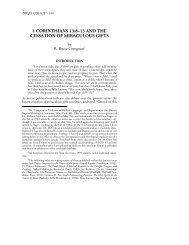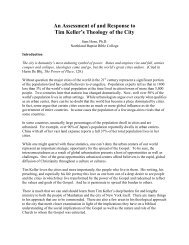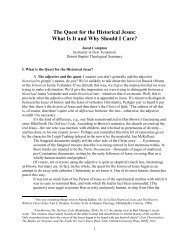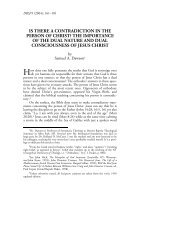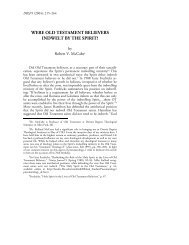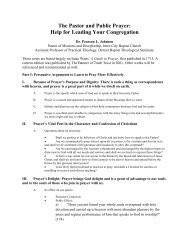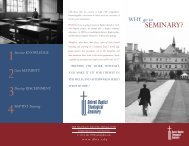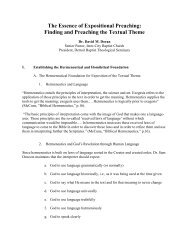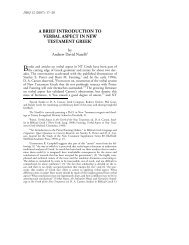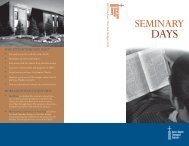Dispensational Sanctification: A Misnomer - Detroit Baptist ...
Dispensational Sanctification: A Misnomer - Detroit Baptist ...
Dispensational Sanctification: A Misnomer - Detroit Baptist ...
Create successful ePaper yourself
Turn your PDF publications into a flip-book with our unique Google optimized e-Paper software.
<strong>Dispensational</strong> <strong>Sanctification</strong> 107<br />
Summary<br />
Though we did not take the time to consider the Wesleyan and<br />
Pentecostal views of justification, we must note that these models do<br />
propose a strongly Arminian approach to salvation. In such a theological<br />
scheme, God’s election is based upon an individual’s decision to be<br />
saved. This approach is also tied to their understanding of sanctification<br />
which is likewise based upon the believer’s decision to grow. Reformed,<br />
Keswick, and Chaferian scholars would all disagree with the<br />
Arminian approach to justification. However, both the Keswick and<br />
Chaferian schools would agree that the believer’s post-conversion dedication<br />
or crisis is necessary before sanctification begins. 64 The Reformed<br />
model, on the other hand, would suggest that God initiates<br />
both justification and sanctification in those whom He elects.<br />
The Wesleyan, Pentecostal, Keswick, and Chaferian models all<br />
agree that some form of a post-conversion decision is necessary before<br />
“real” or “victorious” growth can occur. While all acknowledge the<br />
work of God in sanctification, all appear to place a great responsibility<br />
upon believers themselves to initiate the growth process. On the other<br />
hand, the Reformed model proposes that believers will grow inevitably<br />
because of their conversion to Christ. Believers are responsible to obey<br />
and will do so because of the Spirit’s work in their lives. 65<br />
Finally, the relationship between justification and sanctification is<br />
viewed as inevitable and necessary in the Reformed model while in the<br />
Wesleyan, Pentecostal, Keswick and Chaferian models this relationship<br />
is understood as merely possible or potential. 66<br />
CONCLUSION<br />
Our study has shown that there are several scholars who have<br />
equated the Chaferian model of sanctification with dispensationalism.<br />
64<br />
Walvoord, “Augustinian-<strong>Dispensational</strong> Perspective,” p. 235, writes, “One’s<br />
experience of sanctification is clearly conditioned on one’s response to the sanctification<br />
that the Holy Spirit intends to provide…. Though sanctification is a work of God<br />
in the heart of the individual, it is accomplished only in harmony with the human<br />
response.”<br />
65<br />
Turner (review of Five Views, pp. 94–98) makes this same point several times by<br />
suggesting that the four views are contrasted with Reformed teaching in regard to the<br />
necessity of post-conversion experiences. He writes (p. 98): “Thus, there may only be<br />
two views of sanctification presented in this volume.”<br />
66<br />
For a more thorough treatment of this entire discussion see Combs, “The Disjunction<br />
Between Justification and <strong>Sanctification</strong> in Contemporary Evangelical Theology,”<br />
pp. 19–33; and Jonathan R. Pratt, “The Relationship between Justification and<br />
<strong>Sanctification</strong> in Romans 5–8,” (Ph.D. diss., Dallas Theological Seminary, 1999), pp.<br />
9–39.



